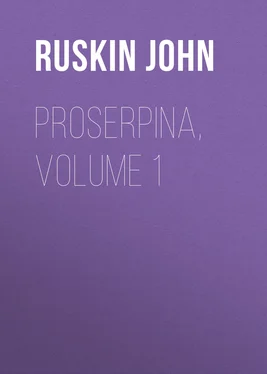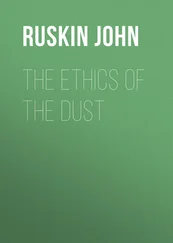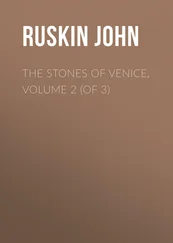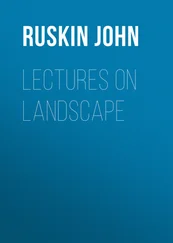John Ruskin - Proserpina, Volume 1
Здесь есть возможность читать онлайн «John Ruskin - Proserpina, Volume 1» — ознакомительный отрывок электронной книги совершенно бесплатно, а после прочтения отрывка купить полную версию. В некоторых случаях можно слушать аудио, скачать через торрент в формате fb2 и присутствует краткое содержание. Жанр: foreign_antique, Биология, literature_19, foreign_edu, на английском языке. Описание произведения, (предисловие) а так же отзывы посетителей доступны на портале библиотеки ЛибКат.
- Название:Proserpina, Volume 1
- Автор:
- Жанр:
- Год:неизвестен
- ISBN:нет данных
- Рейтинг книги:3 / 5. Голосов: 1
-
Избранное:Добавить в избранное
- Отзывы:
-
Ваша оценка:
- 60
- 1
- 2
- 3
- 4
- 5
Proserpina, Volume 1: краткое содержание, описание и аннотация
Предлагаем к чтению аннотацию, описание, краткое содержание или предисловие (зависит от того, что написал сам автор книги «Proserpina, Volume 1»). Если вы не нашли необходимую информацию о книге — напишите в комментариях, мы постараемся отыскать её.
Proserpina, Volume 1 — читать онлайн ознакомительный отрывок
Ниже представлен текст книги, разбитый по страницам. Система сохранения места последней прочитанной страницы, позволяет с удобством читать онлайн бесплатно книгу «Proserpina, Volume 1», без необходимости каждый раз заново искать на чём Вы остановились. Поставьте закладку, и сможете в любой момент перейти на страницу, на которой закончили чтение.
Интервал:
Закладка:
9. "Always fibrous and divided"? But many roots are quite hard and solid!
No; the active part of the root is always, I believe, a fibre. But there is often a provident and passive part—a savings bank of root—in which nourishment is laid up for the plant, and which, though it may be underground, is no more to be considered its real root than the kernel of a seed is. When you sow a pea, if you take it up in a day or two, you will find the fibre below, which is root; the shoot above, which is plant; and the pea as a now partly exhausted storehouse, looking very woful, and like the granaries of Paris after the fire. So, the round solid root of a cyclamen, or the conical one which you know so well as a carrot, are not properly roots, but permanent storehouses,—only the fibres that grow from them are roots. Then there are other apparent roots which are not even storehouses, but refuges; houses where the little plant lives in its infancy, through winter and rough weather. So that it will be best for you at once to limit your idea of a root to this,—that it is a group of growing fibres which taste and suck what is good for the plant out of the ground, and by their united strength hold it in its place; only remember the thick limbs of roots do not feed, but only the fine fibres at the ends of them which are something between tongues and sponges, and while they absorb moisture readily, are yet as particular about getting what they think nice to eat as any dainty little boy or girl; looking for it everywhere, and turning angry and sulky if they don't get it.
10. But the root has, it seems to me, one more function, the most important of all. I say, it seems to me, for observe, what I have hitherto told you is all (I believe) ascertained and admitted; this that I am going to tell you has not yet, as far as I know, been asserted by men of science, though I believe it to be demonstrable. But you are to examine into it, and think of it for yourself.
There are some plants which appear to derive all their food from the air—which need nothing but a slight grasp of the ground to fix them in their place. Yet if we were to tie them into that place, in a framework, and cut them from their roots, they would die. Not only in these, but in all other plants, the vital power by which they shape and feed themselves, whatever that power may be, depends, I think, on that slight touch of the earth, and strange inheritance of its power. It is as essential to the plant's life as the connection of the head of an animal with its body by the spine is to the animal. Divide the feeble nervous thread, and all life ceases. Nay, in the tree the root is even of greater importance. You will not kill the tree, as you would an animal, by dividing its body or trunk. The part not severed from the root will shoot again. But in the root, and its touch of the ground, is the life of it. My own definition of a plant would be "a living creature whose source of vital energy is in the earth" (or in the water, as a form of the earth; that is, in inorganic substance). There is, however, one tribe of plants which seems nearly excepted from this law. It is a very strange one, having long been noted for the resemblance of its flowers to different insects; and it has recently been proved by Mr. Darwin to be dependent on insects for its existence. Doubly strange therefore, it seems, that in some cases this race of plants all but reaches the independent life of insects. It rather settles upon boughs than roots itself in them; half of its roots may wave in the air.
11. What vital power is, men of science are not a step nearer knowing than they were four thousand years ago. They are, if anything, farther from knowing now than then, in that they imagine themselves nearer. But they know more about its limitations and manifestations than they did. They have even arrived at something like a proof that there is a fixed quantity of it flowing out of things and into them. But, for the present, rest content with the general and sure knowledge that, fixed or flowing, measurable or immeasurable—one with electricity or heat or light, or quite distinct from any of them—life is a delightful, and its negative, death, a dreadful thing, to human creatures; and that you can give or gather a certain quantity of life into plants, animals, and yourself by wisdom and courage, and by their reverses can bring upon them any quantity of death you please, which is a much more serious point for you to consider than what life and death are.
12. Now, having got a quite clear idea of a root properly so called, we may observe what those storehouses, refuges, and ruins are, which we find connected with roots. The greater number of plants feed and grow at the same time; but there are some of them which like to feed first and grow afterwards. For the first year, or, at all events, the first period of their life, they gather material for their future life out of the ground and out of the air, and lay it up in a storehouse as bees make combs. Of these stores—for the most part rounded masses tapering downwards into the ground—some are as good for human beings as honeycombs are; only not so sweet. We steal them from the plants, as we do from the bees, and these conical upside-down hives or treasuries of Atreus, under the names of carrots, turnips, and radishes, have had important influence on human fortunes. If we do not steal the store, next year the plant lives upon it, raises its stem, flowers and seeds out of that abundance, and having fulfilled its destiny, and provided for its successor, passes away, root and branch together.
13. There is a pretty example of patience for us in this; and it would be well for young people generally to set themselves to grow in a carrotty or turnippy manner, and lay up secret store, not caring to exhibit it until the time comes for fruitful display. But they must not, in after-life, imitate the spendthrift vegetable, and blossom only in the strength of what they learned long ago; else they soon come to contemptible end. Wise people live like laurels and cedars, and go on mining in the earth, while they adorn and embalm the air.
14. Secondly, Refuges. As flowers growing on trees have to live for some time, when they are young in their buds, so some flowers growing on the ground have to live for a while, when they are young, in what we call their roots. These are mostly among the Drosidæ 16 16 Drosidæ, in our school nomenclature, is the general name, including the four great tribes, iris, asphodel, amaryllis, and lily. See reason for this name given in the 'Queen of the Air,' Section II.
and other humble tribes, loving the ground; and, in their babyhood, liking to live quite down in it. A baby crocus has literally its own little dome—domus, or duomo—within which in early spring it lives a delicate convent life of its own, quite free from all worldly care and dangers, exceedingly ignorant of things in general, but itself brightly golden and perfectly formed before it is brought out. These subterranean palaces and vaulted cloisters, which we call bulbs, are no more roots than the blade of grass is a root, in which the ear of corn forms before it shoots up.
15. Thirdly, Ruins. The flowers which have these subterranean homes form one of many families whose roots, as well as seeds, have the power of reproduction. The succession of some plants is trusted much to their seeds: a thistle sows itself by its down, an oak by its acorns; the companies of flying emigrants settle where they may; and the shadowy tree is content to cast down its showers of nuts for swines' food with the chance that here and there one may become a ship's bulwark. But others among plants are less careless, or less proud. Many are anxious for their children to grow in the place where they grew themselves, and secure this not merely by letting their fruit fall at their feet, on the chance of its growing up beside them, but by closer bond, bud springing forth from root, and the young plant being animated by the gradually surrendered life of its parent. Sometimes the young root is formed above the old one, as in the crocus, or beside it, as in the amaryllis, or beside it in a spiral succession, as in the orchis; in these cases the old root always perishes wholly when the young one is formed; but in a far greater number of tribes, one root connects itself with another by a short piece of intermediate stem; and this stem does not at once perish when the new root is formed, but grows on at one end indefinitely, perishing slowly at the other, the scars or ruins of the past plants being long traceable on its sides. When it grows entirely underground it is called a root-stock. But there is no essential distinction between a root-stock and a creeping stem, only the root-stock may be thought of as a stem which shares the melancholy humour of a root in loving darkness, while yet it has enough consciousness of better things to grow towards, or near, the light. In one family it is even fragrant where the flower is not, and a simple houseleek is called 'rhodiola rosea,' because its root-stock has the scent of a rose.
Читать дальшеИнтервал:
Закладка:
Похожие книги на «Proserpina, Volume 1»
Представляем Вашему вниманию похожие книги на «Proserpina, Volume 1» списком для выбора. Мы отобрали схожую по названию и смыслу литературу в надежде предоставить читателям больше вариантов отыскать новые, интересные, ещё непрочитанные произведения.
Обсуждение, отзывы о книге «Proserpina, Volume 1» и просто собственные мнения читателей. Оставьте ваши комментарии, напишите, что Вы думаете о произведении, его смысле или главных героях. Укажите что конкретно понравилось, а что нет, и почему Вы так считаете.












